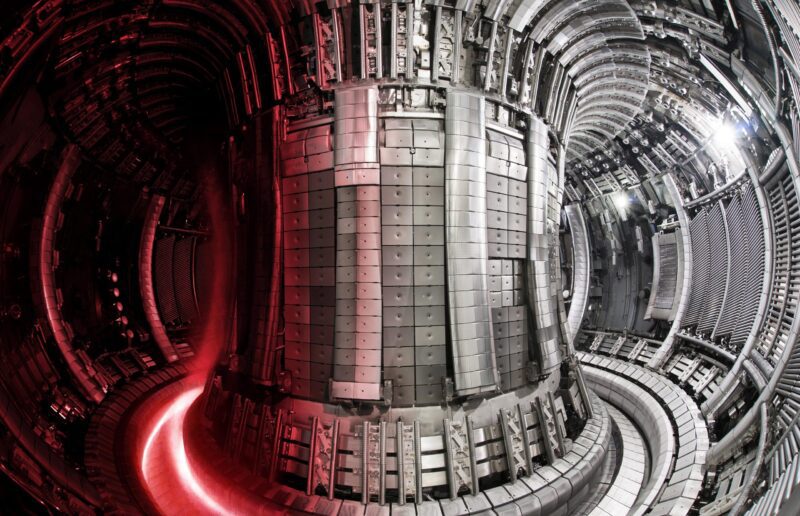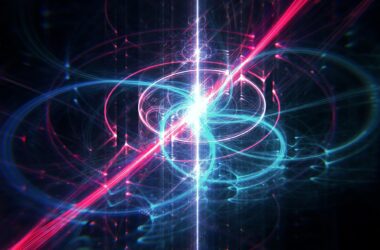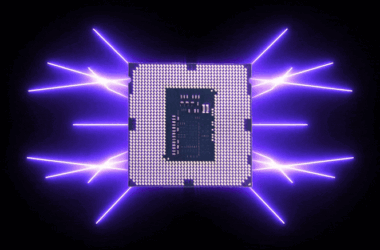
Installation de fusion nucléaire : Intérieur du JET avec plasma superposé. L’énergie de fusion nucléaire pourrait être une source d’énergie durable essentielle pour compléter les énergies renouvelables. Crédit : UKAEA
La vieille blague veut que la fusion nucléaire soit toujours à 30 ans. Cependant, le rêve d’une énergie propre et abondante n’a rien de drôle. Nous avons rencontré un chercheur d’ITER pour faire le point sur les progrès réalisés dans l’installation du réacteur.
En créant de la lumière et de la chaleur par la fusion nucléaire, le Soleil a alimenté la vie sur Terre pendant des milliards d’années. Compte tenu de cette puissance et de cette longévité incroyables, il semble qu’il n’y ait guère de meilleur moyen de produire de l’énergie que d’exploiter les mêmes processus nucléaires qui se produisent dans les étoiles, y compris notre propre soleil.
Les réacteurs à fusion nucléaire visent à reproduire ce processus en faisant fusionner des atomes d’hydrogène pour créer de l’hélium, ce qui libère de l’énergie sous forme de chaleur. Si l’on parvient à maintenir ce processus à grande échelle, on pourrait produire une source d’énergie sûre, propre et presque inépuisable.
La quête a commencé il y a plusieurs dizaines d’années, mais la blague de longue date selon laquelle la fusion nucléaire est toujours à 30 ans de distance pourrait-elle bientôt sembler dépassée ?
Certains l’espèrent, à la suite d’une percée majeure au cours des dernières années. une expérience de fusion nucléaire à la fin de 2021. Cette expérience a eu lieu au Joint European Torus (JET), une installation de recherche située dans l’Oxfordshire, au Royaume-Uni, dans une machine géante en forme de beignet appelée tokamak.
À l’intérieur, des gaz surchauffés appelés plasmas sont générés dans lesquels se produisent les réactions de fusion, contenant des particules chargées qui sont maintenues en place par de puissants champs magnétiques. De tels plasmas peuvent atteindre des températures de 150 millions de degrés Celsius, an unfathomable 10 times hotter than the Sun’s core.
In a sustained five-second burst, researchers in the EUROfusion consortium released a record-breaking 59 megajoules (MJ) of fusion energy. This was almost triple the previous 21.7 MJ record set at the same facility in 1997, with the results touted as “the clearest demonstration in a quarter of a century of the potential for fusion energy to deliver safe and sustainable low-carbon energy.” Follow the link to learn more about the successful nuclear fusion experiment at JET.

View of JET experimental fusion reactor plasma. Credit: © EUROfusion consortium (2022)
The results provided a major boost ahead of the next phase of nuclear fusion’s development. A larger and more advanced version of JET known as ITER (meaning “The Way” in Latin) is under construction on a 180-hectare site in Saint-Paul-lès-Durance, southern France.
ITER, which is being built as a collaboration between 35 nations, including those in the EU, is aimed at further firming up the concept of fusion. One of the most complicated machines ever to be created, it was scheduled to start generating its first plasma in 2025 before entering into high-power operation around 2035 – although researchers on the project expect some delays because of the pandemic.
Major milestone
The results at JET represent a major landmark, said Professor Tony Donné, program manager of the EUROfusion project, a major consortium of 4,800 experts, students, and facilities across Europe. “It’s a huge milestone – the biggest for a long time,” he said.
“It’s confirmed all the modeling, so it has really increased confidence that ITER will work and do what it’s meant to do.” While the energy generated at JET lasted just a few seconds, the aim is to ramp this up to a sustained reaction that produces energy.
The results were the culmination of years of preparation, with Prof Donné explaining that one of the key developments since 1997 involved changing the inner wall of the JET vessel.
“It’s a huge milestone in nuclear fusion – the biggest for a long time. It’s confirmed all the modelling.”
— Prof Tony Donné, EUROfusion
Previously, the wall was made of carbon, but this proved too reactive with the fuel mix of deuterium and tritium, two heavier isotopes – or variants – of hydrogen used in the fusion reaction. This resulted in the formation of hydrocarbons, locking up the tritium fuel in the wall.
In the rebuild, which involved 16 000 components and 4 000 tonnes of metal, the carbon was replaced with beryllium and tungsten to reduce tritium retention. Ultimately, the team was able to cut the amount of trapped fuel by a large multiple, contributing to the success of the recent fusion shot.
DEMO run
In preparation for the next stage of fusion’s epic journey, upgrades to JET ensured that its configuration aligns with the plans for ITER. Further in the future, the next step beyond ITER will be a demonstration power plant known as DEMO, designed to send electricity into the grid – leading on to fusion plants becoming a commercial and industrial reality.
“ITER is a device which will create 10 times more fusion energy than the energy used to heat the plasma,” said Prof Donné. “But as it is an experimental facility, it will not deliver electricity to the grid. For that, we need another device, which we call DEMO. This will really bring us to the foundations for the first generation of fusion power plants.”
Prof Donné added: “JET has shown now that fusion is plausible. ITER has to show that it’s further feasible, and DEMO will need to demonstrate that it really works.”
Planned to provide up to 500 megawatts (MW) to the grid, he thinks it is realistic for DEMO to come into operation around 2050. “We hope to build DEMO much faster than we built ITER, making (use of the) lessons learned,” he said.
Yet there are other key challenges to overcome on the way to getting nuclear fusion up and running. Not least is that while deuterium is abundant in seawater, tritium is extremely scarce and difficult to produce.
“If we get fusion up and running, then really we have a very safe and clean energy source which can give us energy for thousands of years.”
— Prof Tony Donné, EUROfusion
The researchers, therefore, plan to develop a way of generating it inside the tokamak, using a “breeding blanket” containing lithium. The idea is that high-energy neutrons from the fusion reactions will interact with the lithium to create tritium.
Essential energy
Prof Donné said nuclear fusion could prove a pivotal green and sustainable energy source for the future. “I would say it’s essential,” he said. “I’m not convinced that by 2050 we can make the carbon dioxide transition with only renewables, and we need other things.”
And although he says the current method of creating nuclear energy through fission is becoming safer and safer, fusion has key advantages. Proponents for ITER talk of benefits such as an absence of meltdown risk, adding that nuclear fusion does not produce long-lived radioactive waste and that reactor materials can be recycled or reused within 100 to 300 years.
“It’s definitely much safer,” said Prof Donné. Referencing the stigma carried by nuclear energy, he said, “What we see when we interact with the public is that people very often haven’t heard about nuclear fusion. But when we explain the pros and cons, then I think people get positive.”
Referring to Lev Artsimovich, dubbed the “father of the tokamak,” he said, “Artsimovich always said fusion will be there when society really needs it. If we get fusion up and running, then really we have a very safe and clean energy source which can give us energy for thousands of years.”
Research in this article was funded by the EU.
This article was originally published in Horizon, the EU Research & Innovation Magazine.



